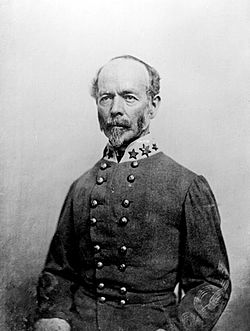Confederate Army of the Shenandoah facts for kids
Quick facts for kids Army of the Shenandoah |
|
|---|---|

Joseph E. Johnston
|
|
| Active | May 1861 – July 1861 |
| Country | |
| Allegiance | |
| Branch | |
| Type | Field army |
| Role | Confederate army in Eastern Theater |
| Engagements | Battle of Hoke's Run First Battle of Bull Run |
| Commanders | |
| Notable commanders |
Joseph E. Johnston |
The Army of the Shenandoah was a group of soldiers who fought for the Confederate States of America during the American Civil War. This army was created to protect the Shenandoah Valley in Virginia during the first few months of the war.
Its most important action was when it moved to help another Confederate army. This happened at the First Battle of Bull Run. After this big battle, the Army of the Shenandoah joined with the other army.
Contents
How the Army Started
The Army of the Shenandoah began with different groups of local soldiers. These groups were called companies and militia. They were sent to take and defend Harpers Ferry, a town in Virginia (which is now in West Virginia).
To get these soldiers organized, a leader named Robert E. Lee first put Thomas J. Jackson in charge. Jackson created five groups of foot soldiers, called regiments. He also formed a group of artillery, which used cannons. These groups became the start of the famous Stonewall Brigade.
On May 15, Joseph E. Johnston took over from Jackson as the commander at Harpers Ferry. He kept getting more regiments from all over the Confederacy. Eventually, he had four large groups of foot soldiers, called brigades. He also had a separate group of cavalry (soldiers on horseback). This cavalry group was the 1st Virginia Cavalry, led by J. E. B. Stuart.
Facing the Union Army
In the middle of June, Union (Northern) forces started moving towards Harpers Ferry. These forces were led by Robert Patterson. Commander Johnston worried that Harpers Ferry was not a good place to defend. So, he had the bridges and equipment in the town destroyed. Then, he moved his army south to Winchester.
Patterson's Union army stayed near the Potomac River and did not chase Johnston. For the next few weeks, both armies watched each other. They only fought one small battle, called Falling Waters, on July 2.
Patterson waited almost two weeks and got more soldiers. Then, he started to move towards Winchester. But he only went about 5 miles (8 km) before he met Stuart's cavalry. Stuart's soldiers were watching Johnston's main army. Patterson stopped again and talked to his officers. They told him to be careful. Also, some of his soldiers were supposed to leave the army soon and refused to stay longer. Because of this, Patterson decided not to attack.
March to Manassas
Patterson's decision allowed Johnston to follow new orders. On July 18, Johnston was told to move his army quickly. He needed to go reinforce P. G. T. Beauregard's Confederate Army of the Potomac at Manassas Junction.
The movement started that evening. Each brigade marched to a place called Piedmont. From there, they boarded a train to Manassas Junction. Since there was only one train, the brigades arrived one at a time. The artillery and cavalry had to march all the way by land. The last groups of Johnston's army arrived on the afternoon of July 21.
The First Battle of Bull Run
Because Joseph Johnston was a higher-ranking general than Beauregard, he took command of both armies. Before Johnston arrived, Beauregard had already planned an attack on the Union army. This Union army was led by Irvin McDowell. The attack was planned for July 21, across a stream called Bull Run.
Johnston approved Beauregard's plan. He let Beauregard give the orders using his name. However, the orders were not very clear. This confused the brigade commanders, and the planned attack did not happen.
On the morning of July 21, McDowell's Union army launched its own attack. They attacked the Confederate left side, which was defended by one of Beauregard's brigades. As the fighting grew bigger, more Confederate brigades moved to help on the left side. Eventually, all four of Johnston's brigades and four of Beauregard's brigades were fighting in this area.
It was during the defense of Henry House Hill that General Jackson got his famous nickname, "Stonewall." His brigade also became known as the Stonewall Brigade.
After the battle, Johnston's and Beauregard's armies were combined. They became part of a larger group called the Department of Northern Virginia. The combined army kept the name "Army of the Potomac." Johnston remained in charge of this larger army. Beauregard stayed as his second-in-command for a while.
Key Leaders at Manassas
At the First Battle of Bull Run, the Army of the Shenandoah was led by General Joseph E. Johnston.
- First Brigade: Led by Brigadier General Thomas J. Jackson. This was the famous Stonewall Brigade.
- Second Brigade: Led by Colonel Francis S. Bartow.
- Third Brigade: Led by Brigadier General Barnard E. Bee.
- Fourth Brigade: Led by Brigadier General Edmund Kirby Smith.
- Cavalry: The 1st Virginia Cavalry was led by Colonel J.E.B. Stuart.
See also
 In Spanish: Ejército del Shenandoah para niños
In Spanish: Ejército del Shenandoah para niños

